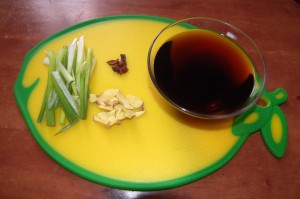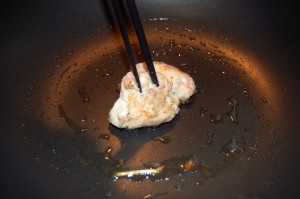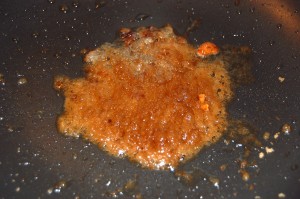Su Dong Po is one of the two or three most beloved poets in Chinese history. So famous was he that the dish he loved most was given his name: Dong Po’s Pork.
It’s quite a treat: you’ll be unsure whether you’re eating the entrée or the dessert. Strangely this dish, one of the most popular in Chinese cuisine, rarely appears on the menu of Chinese restaurants in the U.S.
Preparing the Pork Bellies
Dong Po’s Pork is basically a high-class way of cooking pork bellies – the uncured precursor to bacon.
Buy the pork bellies in thick slices – at least a half-inch thick. Cut them into cubes about 1 inch on a side. You’ll also need a few slices from a ginger root and scallions:
The first step is to boil a pot of water. Add the cubed pork bellies, ginger, and scallion to the boiling water.
Boil for 30 minutes, it will look like this:
Drain the liquid, keeping the solids.
This boiling process removes unpleasant pork flavors, and leaves the pork with a very mild fatty flavor.
Preparing the Sauce
While the pork is being boiled, prepare the cooking sauce. Mix in a small bowl about 2 tbsp soy sauce – we use Kikkoman Teriyaki Marinade and Soy Sauce, but any naturally brewed soy sauce can be used – and a half cup of wine – we used Riesling since we frequently drink that, but any wine will do. Also, cut more ginger and scallions. The traditional Chinese recipe calls for star anise as well:
If whole star anise is unavailable, you can find ground anise or Chinese “5-star” spice in your supermarket spice aisle. However, it would also come out fine if you dispense with the anise; the pork, soy sauce, wine, and caramelized sugar provide most of the taste.
Traditionally, the remainder of the cooking would be done in a Dutch oven or similar pot that retains heat and can be tightly sealed to keep in steam. However, we’ll use a wok.
In the wok, warm some cooking fat. You can use any oil you like – olive oil or coconut oil are fine. We have been using beef tallow lately – here we are melting some fat from a block of beef fat:
Once the oil is warm, add about 2 tbsp rice syrup. Stir as the sugar caramelizes. It’s ready as soon as bubbles appear — about 30 seconds:
We have adopted rice syrup as our sweetener of choice. It is a zero-fructose sweetener, and we like that it provides glucose calories along with its sweet taste: it seems the body evolved to expect sweet tastes to be followed by an infusion of sugar, since zero-calorie sweeteners trigger insulin release. We like our food to fit the body’s evolved expectations. (The traditional sweetener is smaller amount of brown sugar.)
Caramelizing sugar will create some advanced glycation endproducts (AGEs), so this dish is not perfectly healthy – but it is healthy enough for us.
Completing the Dish
Immediately after the rice syrup begins to caramelize, and before it burns, add the cooked pork to the pan and stir to coat the pork evenly.
Then immediately add all the other ingredients.
Cover, briefly raise the heat to bring the wine and soy sauce mixture to a simmer, then lower the heat and let it simmer covered for 30 to 60 minutes.
The object here is to steam the pork and let the sauce flavors combine with the pork. The longer you steam it, the softer the fat becomes and the more it melts in your mouth.
Every 10 to 15 minutes, uncover and stir. If your soy sauce was not salty enough for you, you can add a bit of salt while it is cooking.
By the time you’re done, there will be only a little liquid left. Transfer to a serving bowl.
Dong Po Pork is fantastic with rice. Here’s how we ate it:
Enjoy!






















Recent Comments